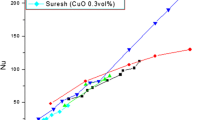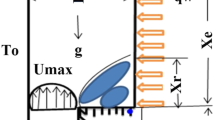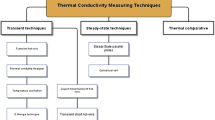Abstract
Nanofluids are obtained by suspending metallic or non-metallic nanoparticles in conventional base liquids and can be employed to increase heat transfer rate in various applications. In this study, the effects of adding three types of nanofluids on turbulent convective heat transfer at the entrance region of a constant wall heat flux tube were experimentally studied. The nanofluids were mixtures of aluminium oxide, copper oxide, and silicon carbide at various nanoparticle volume fractions ranging from 0.0002 to 0.002 in water. The convective heat transfer coefficient was measured at different Reynolds numbers of 10,000–50,000. At these concentrations and Reynolds numbers, a maximum of 11–18% of convection heat transfer coefficient was observed as compared to the base fluid, showing a 6–9% increase on average. In this study, it was observed that changes in the nanoparticle type had no considerable effect on heat transfer coefficient increase. According to the model proposed here, the dimensionless thickness of laminar sub-layer is specified as a functional equation of the volume fraction of nanoparticles for each material.















Similar content being viewed by others
Abbreviations
- A :
-
Tube cross section area (m2)
- C p :
-
Specific heat capacity (J kg−1 K−1)
- D :
-
Tube diameter (m)
- fi:
-
Friction factor (dimensionless)
- h :
-
Heat transfer coefficient (W m−2 K−2)
- k :
-
Thermal conductivity (W m−1 K−1)
- L :
-
Length of tube (m)
- I :
-
Electric current (A)
- m :
-
Mass flow rate (kg s−1)
- Nu :
-
Nusselt number (dimensionless)
- Pr :
-
Prandtl number (dimensionless)
- Q :
-
Input energy (W)
- q :
-
Heat flux (W m−2)
- Re :
-
Reynolds number (dimensionless)
- S :
-
Tube perimeter (m)
- T :
-
Temperature (K)
- u :
-
Mean velocity of fluid (m s−1)
- V :
-
Electric potential difference (V)
- X :
-
Axial distance from the entrance (m)
- δ +v :
-
Dimensionless thickness of the laminar sublayer (dimensionless)
- ΔS :
-
Thickness of tube (m)
- μ :
-
Viscosity (kg m−1 s−1)
- ρ :
-
Density (kg m−3)
- ϕ :
-
Volume fraction (dimensionless)
- b:
-
Bulk
- bf:
-
Base fluid
- nf:
-
Nanofluid
- p:
-
Particle
- th:
-
Thermocouple
- v:
-
Laminar sublayer
- w:
-
Wall
- x:
-
Local length
- RAAD:
-
Relative absolute average deviation
References
Choi SUS, Eastman JA. Enhancing thermal conductivity of fluids with nanoparticles. San Francisco: International Mechanical Engineering Congress and Exposition; 1995.
Pak BC, Cho YI. Hydrodynamic and heat transfer study of dispersed fluids with submicron metallic oxide particles. Exp Heat Trans. 1998;11:151–70.
Hemmat Esfe M, Ahangar MRH, Toghraie D, Hajmohammad MH, Rostamian H, Tourang H. Designing artificial neural network on thermal conductivity of Al2O3–water–EG (60–40%) nanofluid using experimental data. J Therm Anal Calorim. 2016;126:837–43.
Sundar LS, Naik M, Sharma K, Singh M, Reddy TS. Experimental investigation of forced convection heat transfer and friction factor in a tube with Fe3O4 magnetic nanofluid. Exp Therm Fluid Sci. 2012;37:65–71.
Kanna PR, Taler J, Anbumalar V, Kumar AVS, Pushparaj A, Christopher DS. Conjugate heat transfer from sudden expansion using nanofluid. Numer Heat Trans Part A Appl. 2014;67:75–99.
Sajadi A, Kazemi M. Investigation of turbulent convective heat transfer and pressure drop of TiO2/water nanofluid in circular tube. Int Commun Heat Mass Trans. 2011;38:1474–8.
Fotukian S, Esfahany MN. Experimental study of turbulent convective heat transfer and pressure drop of dilute CuO/water nanofluid inside a circular tube. Int Commun Heat Mass Trans. 2010;37:214–9.
Djajadiwanta E, Al-Ansary HA, Al-Dakkan K, Bagabas A, Al-Jakiwi A, Zedan MF. Turbulent convective heat transfer and pressure drop of dilute CuO-water. In 3rd micro and Nano Flows Conference Thessaloniki, Greece, 22–24; August 2011.
Motevasel M, Solaimany Nazar AR, Jamialahmadi M. Experimental investigation of turbulent flow convection heat transfer of MgO/water nanofluid at low concentrations—prediction of aggregation effect of nanoparticles. Int J Heat Technol. 2017;35:755–64.
Esfe MH, Saedodin S, Mahian O, Wongwises S. Heat transfer characteristics and pressure drop of COOH-functionalized DWCNTs/water nanofluid in turbulent flow at low concentrations. Int J Heat Mass Trans. 2014;73:186–94.
Meriläinen A, Seppälä A, Saari K, Seitsonen J, Ruokolainen J, Puisto S, et al. Influence of particle size and shape on turbulent heat transfer characteristics and pressure losses in water-based nanofluids. Int J Heat Mass Trans. 2013;61:439–48.
Zadkhast M, Toghraie D, Karimipour A. Developing a new correlation to estimate the thermal conductivity of MWCNT-CuO/water hybrid nanofluid via an experimental investigation. J Therm Anal Calorim. 2017;129:859–67.
Rayatzadeh HR, Saffar-Avval M, Mansourkiaei M, Abbassi A. Effects of continuous sonication on laminar convective heat transfer inside a tube using water–TiO2 nanofluid. Exp Therm Fluid Sci. 2013;48:8–14.
Lin J-Z, Xia Y, Ku X-K. Pressure drop and heat transfer of nanofluid in turbulent pipe flow considering particle coagulation and breakage. J Heat Trans. 2014;136:111701.
Maddah H, Ghasemi N. Experimental evaluation of heat transfer efficiency of nanofluid in a double pipe heat exchanger and prediction of experimental results using artificial neural networks. Heat Mass Trans. 2017;53:3459–72.
Davarnejad R. Modeling of TiO2-water nanofluid effect on heat transfer and pressure drop. Int J Eng. 2013;27:195–202.
Sahin B, Manay E, Akyurek EF. An experimental study on heat transfer and pressure drop of CuO-water nanofluid. J Nanomater. 2015;2015:1–10.
Yousefi-Lafouraki B, Ramiar A, Ranjbar AA. Numerical simulation of two phase turbulent flow of nanofluids in confined slot impinging jet. Flow Turb Combs. 2016;97:571–89.
Guzei DV, Minakov AV, Rudyak VY. Investigation of heat transfer of nanofluids in turbulent flow in a cylindrical channel. Fluid Dyn. 2016;51:189–99.
Torii S. Turbulent heat transfer behavior of nanofluid in a circular tube heated under constant heat flux. Adv Mech Eng. 2010;2:917612.
Heris SZ, Etemad S, Esfahany MN. Experimental investigation of oxide nanofluids laminar flow convective heat transfer. Int Commun Heat Mass Trans. 2006;33:529–35.
Azmi W, Sharma K, Mamat R, Anuar S. Turbulent forced convection heat transfer of nanofluids with twisted tape insert in a plain tube. Energy Procedia. 2014;52:296–307.
Hausen H. New equation for heat transfer in free or force flow. Allg Warmetchn. 1959;9:75–9.
Gnielinski V. Warmeu bergang in Rohern, VDI, Warmeatlas, Fifthed, VDI_Verlag, Dusseldorf (1986).
Ghajar AJ, Tam L-M. Heat transfer measurements and correlations in the transition region for a circular tube with three different inlet configurations. Exp Therm Fluid Sci. 1994;8:79–90.
Xuan Y, Roetzel W. Conceptions for heat transfer correlation of nanofluids. Int J Heat Mass Trans. 2000;43:3701–7.
Duangthongsuk W, Wongwises S. Effect of thermophysical properties models on the predicting of the convective heat transfer coefficient for low concentration nanofluid. Int Commun Heat Mass Trans. 2008;35:1320–6.
Einstein A. A new determination of molecular dimensions. Ann Phys. 1906;324:289–306.
Brinkman HC. The viscosity of concentrated suspensions and solutions. J Chem Phys. 1952;20:571.
Wang X, Xu X, Choi SUS. Thermal conductivity of nanoparticle—fluid mixture. J Thermophys Heat Trans. 1999;13:474–80.
Motevasel M, Solaimany Nazar AR, Jamialahmadi M. The effect of nanoparticles aggregation on the thermal conductivity of nanofluids at very low concentrations: experimental and theoretical evaluations. Heat Mass Trans. 2017;54:125–33.
Motevasel M, Soleimanynazar A, Jamialahmadi M. Comparing mathematical models to calculate the thermal conductivity of nanofluids. Am J Oil Chem Technol. 2014;2(11):359–69.
Garnett JCM. Colours in metal glasses and in metallic films. Proc R Soc Lond. 1904;73:443–5.
Moffat RJ. Describing the uncertainties in experimental results. Exp Therm Fluid Sci. 1988;1:3–17.
Wen D, Ding Y. Formulation of nanofluids for natural convective heat transfer applications. Int J Heat Fluid Flow. 2005;26:855–64.
Buongiorno J. Convective transport in nanofluids. J Heat Trans. 2006;128:240.
Prandtl L. Fuehrer Durch dic stroemungslenhre. Braunschweig: Vieweg; 1994. p. 359.
Mcnab G, Meisen A. Thermophoresis in liquids. J Colloid Interface Sci. 1973;44:339–46.
Filoneko GK. Hydraulic resistance in pipes. Teploenergetikal. 1954;1:40–4.
Acknowledgements
The authors would like to express their appreciation to the Petroleum University of Technology (PUT) for providing financial support for this study.
Author information
Authors and Affiliations
Corresponding author
Rights and permissions
About this article
Cite this article
Motevasel, M., Solaimany Nazar, A.R. & Jamialahmadi, M. Experimental study on turbulent convective heat transfer of water-based nanofluids containing alumina, copper oxides and silicon carbide nanoparticles. J Therm Anal Calorim 135, 133–143 (2019). https://doi.org/10.1007/s10973-018-7314-8
Received:
Accepted:
Published:
Issue Date:
DOI: https://doi.org/10.1007/s10973-018-7314-8




